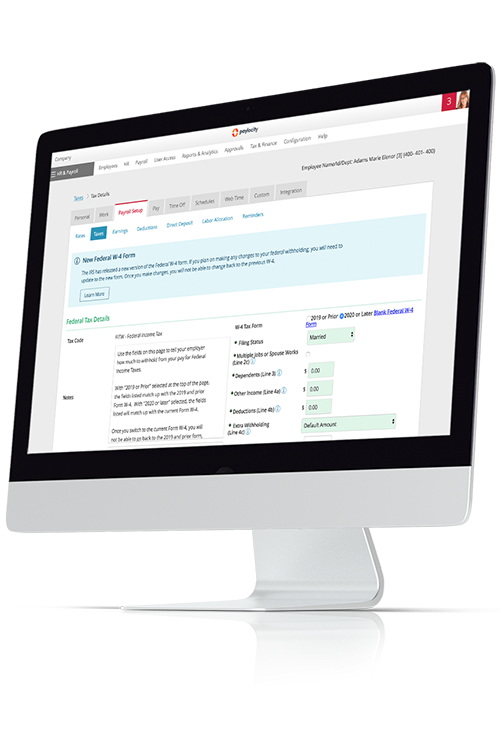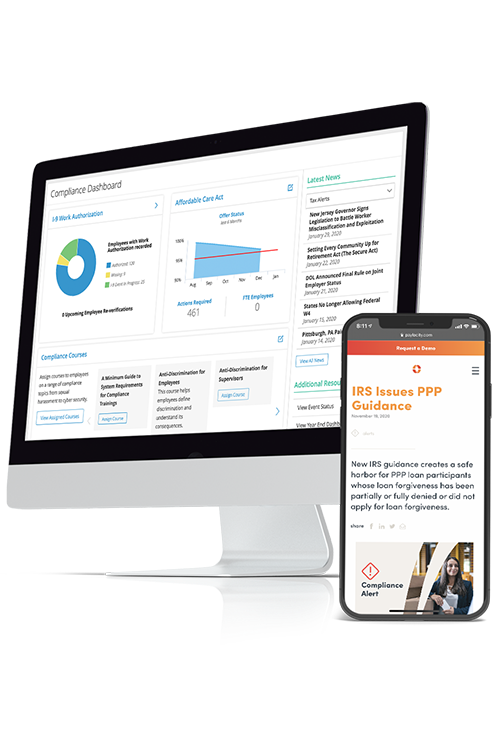resources
New Payroll Tax Laws for 2023
December 29, 2022

At A Glance
With tax year 2022 coming to an end, there are several new laws becoming effective on January 1, 2023. See below for a brief synopsis of the upcoming laws along with federal, state, and local tax updates.
Federal Tax Updates for 2023
The Social Security Administration (SSA) announced the Social Security wage base limit would increase to $160,200 for tax year 2023 an increase of $13,200 from $147,000, in 2022.
The Social Security and Medicare tax for tax year 2023 will remain unchanged. The Social security tax rate remains at 6.2% for 2023 up to the Social Security wage base limit. The maximum social security tax employees and employers will each pay in 2023 is $9,932.40 an increase of $818.40 from tax year 2022.
The Medicare tax rate for tax year 2023 remains at 1.45% and applies to all covered earnings for employees and employers. There is no wage base limit for Medicare. In addition, if an individual’s earned income exceeds $200,000 ($250,000 for married couples filing jointly), the excess income amount is subject to additional Medicare tax rate of 0.9%.
State Unemployment Insurance Wage Base Limits
Jurisdiction | Taxable Wage base | Jurisdiction | Taxable Wage base |
|---|---|---|---|
Alabama | $8,000 (2022) $8,000 (2023) | Montana | $38,100 (2022) $40,500 (2023) |
Alaska | $45,200 (2022) $47,100 (2023) | Nebraska | $9,000 (2022) $9,000 (2023) |
Arizona | $7,000 (2022) $8,000 (2023) | Nevada | $36,600 (2022) $40,100 (2023) |
Arkansas | $7,000 (2022) $10,000 (2023) | New Hampshire | $14,000 (2022) $14,000 (2023) |
California | $,7000 (2022) $7,000 (2023) | New Jersey | $39,800 (2022) $41,100 (2023) |
California SDI | $145,600 (2022) $153,564 (2023) | New Jersey TDI EE | $151,900 (2022) $156,800 (2023) |
Colorado | $17,000 (2022) $20,400 (2023) | New Mexico | $28,700 (2022) $30,100 (2023) |
Connecticut | $15,000 (2022) $15,000 (2023) | New York | $12,000 (2022) $12,300 (2023) |
Delaware | $14,500 (2022) $14,500 (2023) | North Carolina | $28,000 (2022) $29,600 (2023) |
District of Columbia | $9,000 (2022) $9,000 (2023) | North Dakota | $38,400 (2022) $40,800 (2023) |
Federal | $147,000 (2022) $160,200 (2023) | Ohio | $9,000 (2022) $9,000 (2023) |
Florida | $7,000 (2022) $7,000 (2023) | Oklahoma | $24,000 (2022) $25,700 (2023) |
Georgia | $9,500 (2022) $9,500 (2023) | Oregon | $47,700 (2022) $50,900 (2023) |
Hawaii | $51,600 (2022) $56,700 (2023) | Pennsylvania | $10,000 (2022) $10,000 (2023) |
Idaho | $46,500 (2022) $49,900 (2023) | Puerto Rico | $7,000 (2022) $7,000 (2023) |
Illinois | $12,960 (2022) $12,960 (2023) | Rhode Island | $24,600 (2022) $28,200 (2023) |
Indiana | $9,500 (2022) $9,500 (2023) | South Carolina | $14,000 (2022) $14,000 (2023) |
Iowa | $34,800 (2022) $36,100 (2023) | South Dakota | $15,000 (2022) $15,000 (2023) |
Kansas | $14,000 (2022) $14,000 (2023) | Tennessee | $7,000 (2022) $7,000 (2023) |
Kentucky | $11,100 (2022) $11,100 (2023) | Texas | $9,000 (2022) $9,000 (2023) |
Louisiana | $7,700 (2022) $7,700 (2023) | Utah | $41,600 (2022) $44,800 (2023) |
Maine | $12,000 (2022) $12,000 (2023) | Vermont | $15,500 (2022) $13,500 (2023) |
Maryland | $8,500 (2022) $8,500 (2023) | Virgin Island | $30,800 (2022) $30,800 (2023) |
Massachusetts | $15,000 (2022) $15,000 (2023) | Virginia | $8,000 (2022) $8,000 (2023) |
Michigan | $9,500 (2022) $9,500 (2023) | Washington | $62,500 (2022) $67,600 (2023) |
Minnesota | $38,000 (2022) $40,000 (2023) | West Virginia | $9,000 (2022) $9,000 (2023) |
Mississippi | $14,000 (2022) $14,000 (2023) | Wisconsin | $14,000 (2022) $14,000 (2023) |
Missouri | $11,000 (2022) $10,500 (2023) | Wyoming | $27,700 (2022) $29,100 (2023) |
State Minimum Wage Rates effective January 1st, 2023
Jurisdiction | Minimum Wage | Jurisdiction | Minimum Wage |
|---|---|---|---|
Alabama | $7.25 (2022) $7.25 (2023) | Missouri | $11.15 (2022) $12.00 (2023) |
Alaska | $10.34 (2022) $10.85 (2023) | Montana | $9.20 (2022) $9.95 (2023) |
Arizona | $12.80 (2022) $13.85 (2023) | Nebraska | $9.00 (2022) $10.50 (2023) |
Arkansas | $11.00 (2022) $11.00 (2023) | Nevada | $10.50, $9.50 w/ health benefits (2022) $10.25, $9.50 w/ health benefits (2023) |
California | $15 (large employer) & $14 (small employer) (2022) $15.50 (2023) | New Hampshire | $7.25 (2022) $7.25 (2023) |
Colorado | $12.56 (2022) $13.65 (2023) | New Jersey | $13 (large employer) & $11.90 (small employer) (2022) $14.13 (large employer) & $12.93 (small employer) (2023) |
Connecticut | $14.00 (2022) $14.00 (2023) | New Mexico | $11.50 (2022) $12.00 (2023) |
Delaware | $10.50 (2022) $11.75 (2023) | New York | $15.00 New York City, Nassau, Suffolk, & Westchester counties; the rest of the state: $13.20 (2022) $15 per hour in New York City; Long Island & Westchester. Remainder of New York, $14.20 per hour (2023) |
District of Columbia | $15.20 (2022) $16.10 (2023) | North Carolina | $7.25 (2022) $7.25 (2023) |
Federal | $7.25 (2022) $7.25 (2023) | North Dakota | $7.25 (2022) $7.25 (2023) |
Florida | $11.00 (2022) $11.00 (2023) | Ohio | $9.30 (2022) $10.10 (2023) |
Georgia | $5.15 (2022) $7.25 (2023) | Oklahoma | $7.25 (2022) $7.25 (2023) |
Hawaii | $10.10 (2022) $12.00 (2023) | Oregon | Metro: $14.75 (2022) Metro: $14.75 (2023) |
Idaho | $7.25 (2022) $7.25 (2023) | Pennsylvania | $7.25 (2022) $7.25 (2023) |
Illinois | $12.00 (2022) $13.00 (2023) | Rhode Island | $12.25 (2022) $13.00 (2023) |
Indiana | $7.25 (2022) $7.25 (2023) | South Carolina | $7.25 (2022) $7.25 (2023) |
Iowa | $7.25 (2022) $7.25 (2023) | South Dakota | $9.95 (2022) $10.80 (2023) |
Kansas | $7.25 (2022) $7.25 (2023) | Tennessee | $7.25 (2022) $7.25 (2023) |
Kentucky | $7.25 (2022) $7.25 (2023) | Texas | $7.25 (2022) $7.25 (2023) |
Louisiana | $7.25 (2022) $7.25 (2023) | Utah | $7.25 (2022) $7.25 (2023) |
Maine | $12.75 (2022) $13.80 (2023) | Vermont | $12.55 (2022) $13.18 (2023) |
Maryland | $12.50 (large employer) & $12.20 (small employer) (2022) $13.25 (15+ EEs) & $12.80 (<14 EEs) (2023) | Virginia | $11.00 (2022) $12.00 (2023) |
Massachusetts | $14.25 (2022) $15.00 (2023) | Washington | $14.49 (2022) $13.74 (2023) |
Michigan | $9.87 (2022) $10.10 (2023) | West Virginia | $8.75 (2022) $8.75 (2023) |
Minnesota | $10.33 (large employer) & $8.42 (small employer) (2022) $10.59 (large employer) & $8.63 (small employer) (2023) | Wisconsin | $7.25 (2022) $7.25 (2023) |
Mississippi | $7.25 (2022) $7.25 (2023) | Wyoming | $5.15 (2022) $5.15 (2023) |
Local Minimum Wage Rates effective January 1st, 2023
Locality | Rate | Locality | Rate |
|---|---|---|---|
Flagstaff, AZ | $16.80 | San Carlos, CA | $16.32 |
Tucson, AZ | $13.85 | San Diego, CA | $16.25 |
Alameda, CA | $15.75 | San Diego, CA | $16.30 |
Bel Mont, CA | $17.35 | San Jose, CA | $17.00 |
Burlingame, CA | $16.47 | San Mateo, CA | $17.35 |
Cupertino, CA | $17.20 | Santa Clara, CA | $16.34 (large employer)/$15.00 (small employer) |
Daly City, CA | $16.07 | Santa Monica, CA | $15.96 |
East Palo Alto, CA | $16.50 | South San Francisco, CA | $16.70 |
El Cerrito, CA | $17.35 | Sunnyvale, CA | $17.95 |
Half Moon bay, CA | $16.45 | Denver, CO | $17.29 |
Hayward, CA | $16.34(large employer)/$15.00(small employer) | Minneapolis, MN | $15.19(large employer)/$14.50(small employer) |
Los Altos, CA | $17.20 | Albuquerque, NM | $12.00 |
Malibu, CA | $15.96 | Las Cruces, NM | $12.00 |
Novato, CA | $16.32 | Areas outside Westchester County (NY) | $14.20 |
Palo Alto, CA | $17.25 | SeaTac, WA | $19.06 for hospitality and transportation employees |
Petaluma, CA | $17.06 | Seattle, WA | $18.69(large employers/$16.50(small employers) |
Redwood City, CA | $17.00 | Tukwila, WA | $19.06 |
Paid Family and Medical Leave Rates Effective 1/1/2023
Jurisdiction | 2023 Rate | Paid By |
|---|---|---|
California | 0.9% | Employees |
Connecticut | 0.5% | Employees |
New Jersey | 0.00006 | Employees |
New York | 0.455% | Employees |
Rhode Island | 1.1% | Employees |
District Of Columbia | 0.26% | Employees |
Washington | 0.8% | Employers & Employees |
*New Hampshire | TBD | Voluntary Program |
Colorado, Massachusetts, and Oregon have different contribution rates depending on the number of eligible employees.
Colorado: 0.9%. Paid by employer and employees.
ER | EE | |
|---|---|---|
9 or less EE | 0% | 0.45% |
10 or more EE | 40% | 0.45% |
Massachusetts: 0.63% (Medical: 0.52%, Family: 0.11%). Paid for by employer and employees.
25 or More Employees
Medical | Family | |
|---|---|---|
ER | 0.312% (0.52%) | 0% |
EE | 0.208% | 0.11% |
25 or Fewer Employees
Medical | Family | |
|---|---|---|
ER | 0% | 0% |
EE | 0.208% | 0.11% |
Oregon: 1% up to the wage cap. Paid by employer and employees.
ER | EE | |
|---|---|---|
24 or less EE | 0% | 60% |
25 or more EE | 40% | 60% |
Next Steps
For more information on tax laws and local legislation, please visit our resource library. We will continue to communicate updates as they become available.
Thank you for choosing Paylocity as your Payroll Tax and HCM partner. This information is provided as a courtesy, may change and is not intended as legal or tax guidance. Employers with questions or concerns outside the scope of a Payroll Service Provider are encouraged to seek the advice of a qualified CPA, Tax Attorney or Advisor.


